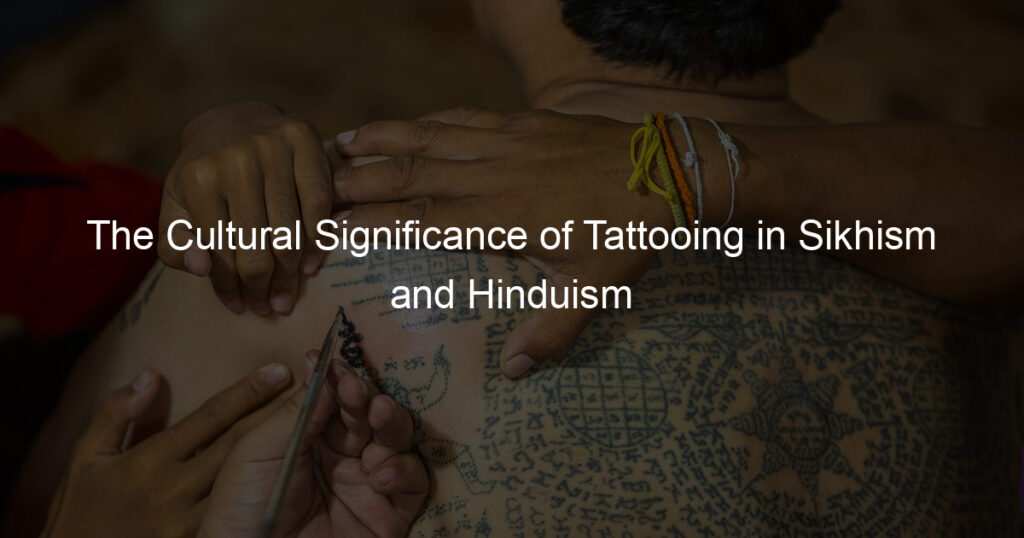Sikhism and Hinduism are two of the world’s oldest religions, and they both have a rich history of tattooing.
Tattoos have long been used as a form of self-expression and body art in these cultures, and they continue to be popular among Sikhs and Hindus today.
Whether you’re a tattoo lover, artist, or enthusiast, it’s interesting to explore the cultural significance of tattoos in these ancient faiths. Keep reading to learn more!
What does Sikhism say about tattoos?
Sikhism does not officially forbid tattoos, however, it does discourage them as the practice of altering God’s creation goes against one of the key principles of their faith.
In its place, Sikhs often choose to highlight their faith and devotion to their beliefs by wearing traditional articles of faith.
It is believed that the adornment of these articles shows a commitment to Sikhism, this process doing more to honor God than getting a tattoo ever could.
Ultimately, each individual must decide for themselves whether they choose to indulge in the practice or not – but taking time to learn more about your faith first can certainly help in making an informed decision.
What is the significance of the tattoo in their culture?
Tattoos have been an important part of many cultures across the globe, but they can mean different things to different people. For some, a tattoo might be a way to commemorate an incredible journey or event.
Others may choose to mark their body as a symbol of their identity and serve as armor in interesting life events. And yet others use tattoos as works of art to show off and express themselves visually.
Whatever their reason, one universal truth remains: tattoos are significant in terms of culture if they represent somebody’s beliefs, values, and understanding. From family bonds to religious rituals and self-expression – everyone has their reasons for getting inked.
What does the tattoo mean in Hinduism?
The concept of tattooing has been around for many centuries, with its origins in Hinduism. In ancient India, tattoos served religious and cultural purposes, representing a person’s spiritual journey and enhancing the wearer’s beauty.
It was said to bring protection from negative energies, as well as connect an individual with their returning soul.
Today, Hindus utilize small symbols and mantras (traditional utterances believed to have spiritual power) in tattoo form to honor their gods while they live life in the physical realm.
Interestingly, having a visible representation of this divine connection can signify both humility and strength to other members of the Hindu community.
Although Hfordus don’t need to have tattoos representing their faith, those who wear them are often viewed with respect and admiration!
Are tattoos part of Hinduism?
Although they may appear so, tattoos are not part of Hinduism. Depending on the region, some Hindus may get certain types of tattoos to show their spirituality or religious devotion, but this is believed by many within the faith to be a modern-day phenomenon.
Historically Hindus were the first to popularize body art in India with elaborate mehendi decorations, however, these are primarily for aesthetics, not religious reasons.
For those who practice forms of Hinduism that accept body art and tattoos, it can be a beautiful way to express oneself and connect with their faith.
Ultimately though, getting a tattoo has little to do with one’s actual beliefs; practitioners are free to interpret their religion differently when considering this decision.
Can you get tattoos if you are Sikh?
Traditionally, Sikhism is opposed to body art due to the sixth principle, which calls for “Kesh” or uncut hair. This means that followers of this faith reject outward forms of expression such as tattoos.
However, in recent years some Sikhs have begun using tattoos and other forms of body art to represent their faith and unique identity. For instance, by getting a khanda – the symbol of Sikhism – as a tattoo.
Many adherents view this as an important way for them to honor their beliefs while still expressing themselves artistically. Ultimately, it’s up to each Sikh to decide if getting a tattoo is in line with their faith.
What is the important symbol of Sikhism?
The Sikh faith is unified under the powerful symbol of the Khanda, a double-edged sword that is set atop a circular shield and flanked by two single-edged swords.
This meaningful emblem demonstrates three of the critical principles that Sikhs rely on in their everyday lives: justice, hard work, and sincerity.
Beyond simply being an emblem for reflection, the Khanda serves as a reminder for Sikhs to be kind and mindful in all aspects of life – a call for universal acceptance and justice for all.
Conclusion
Tattoos have always been a popular form of body art, but they carry different meanings in different cultures. In Sikhism and Hinduism, tattoos are seen as a way to show reverence for religious figures and emphasize one’s devotion to their faith.
For Sikhs, tattooing is also a way to protect themselves from harm. Hindus may also see tattoos as a form of self-expression or as an auspicious mark that indicates their social status or caste.
Whatever the reason, it is clear that tattoos hold deep meaning for many people who practice Sikhism and Hinduism.














